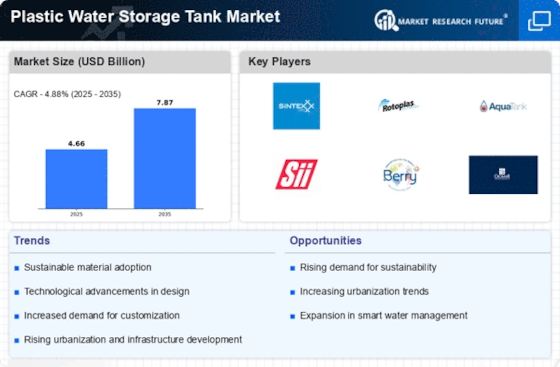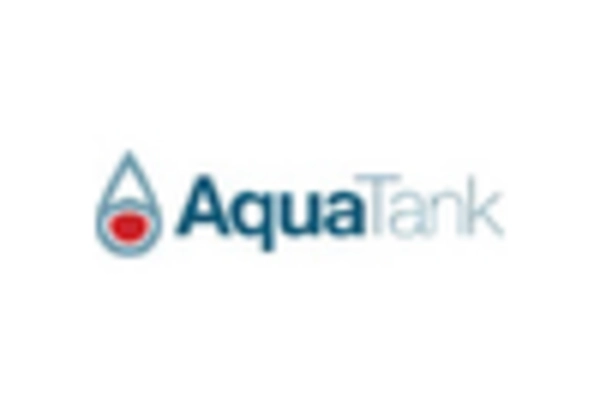Growth in Agricultural Sector
The growth in the agricultural sector is a vital driver for the Plastic Water Storage Tank Market. As agricultural practices evolve, the need for efficient irrigation and water management systems becomes increasingly critical. Plastic water storage tanks are widely utilized in agriculture for storing water for irrigation, livestock, and other farming needs. The rising global population and the corresponding demand for food production are pushing farmers to adopt more efficient water storage solutions. Recent data indicates that the agricultural sector's demand for water storage tanks is expected to grow by approximately 6% annually. This trend underscores the importance of plastic water storage tanks in supporting sustainable agricultural practices and ensuring food security.
Government Regulations and Initiatives
Government regulations and initiatives aimed at promoting sustainable water management practices significantly influence the Plastic Water Storage Tank Market. Many governments are implementing policies that encourage the use of eco-friendly materials and technologies in water storage solutions. For instance, regulations mandating the use of non-toxic and recyclable materials in water storage systems are becoming more common. This shift not only enhances public health and safety but also aligns with broader environmental goals. As a result, manufacturers are increasingly focusing on producing plastic water storage tanks that meet these regulatory standards, thereby expanding their market reach. The anticipated growth in this sector is expected to be around 6% over the next few years, driven by these regulatory frameworks.
Technological Innovations in Tank Design
Technological innovations in tank design and manufacturing processes are reshaping the Plastic Water Storage Tank Market. Advances in materials science have led to the development of lighter, more durable, and UV-resistant plastics, which enhance the longevity and performance of water storage tanks. Additionally, the integration of smart technologies, such as sensors for monitoring water levels and quality, is becoming increasingly prevalent. These innovations not only improve the functionality of plastic water storage tanks but also cater to the growing consumer demand for smart home solutions. The market for technologically advanced water storage solutions is expected to grow by approximately 7% in the coming years, reflecting the increasing consumer preference for high-tech products.
Increased Awareness of Water Conservation
The heightened awareness of water conservation practices is a significant driver in the Plastic Water Storage Tank Market. As water scarcity becomes a pressing issue in many regions, individuals and organizations are actively seeking ways to optimize water usage. Plastic water storage tanks play a crucial role in rainwater harvesting and greywater recycling systems, which are gaining traction among environmentally conscious consumers. This trend is further supported by educational campaigns and community initiatives promoting sustainable water practices. The market for plastic water storage tanks is projected to expand by around 5% as more consumers recognize the benefits of water conservation and invest in effective storage solutions.
Rising Demand for Water Storage Solutions
The increasing demand for reliable water storage solutions is a primary driver in the Plastic Water Storage Tank Market. As populations grow and urban areas expand, the need for efficient water management systems becomes more pronounced. According to recent estimates, the demand for water storage tanks is projected to rise by approximately 5% annually. This trend is particularly evident in regions experiencing rapid urbanization, where traditional water supply systems may be inadequate. Consequently, plastic water storage tanks, known for their durability and cost-effectiveness, are becoming the preferred choice for both residential and commercial applications. The versatility of these tanks allows for various uses, including agricultural, industrial, and domestic purposes, further fueling their market growth.

















Leave a Comment